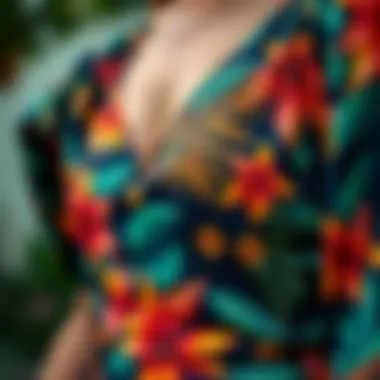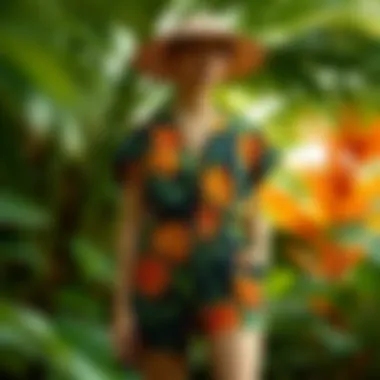The Journey of the Tropical Print Romper: Style and Sustainability


Intro
In the vast realm of fashion, certain pieces have the uncanny ability to transcend mere trends, becoming staples that echo through wardrobes for seasons on end. The tropical print romper is one such garment. What started as an underdog in the fashion world has blossomed into a cherished item for many, elegantly blending style with comfort. This article embarks on a journey to unpack the evolution of the tropical print romper, examining its roots, current relevance, and significance to both culture and sustainability.
From vibrant floral patterns to bold, colorful designs reminiscent of sun-soaked beaches, tropical print rompers not only encompass a flair for style but also narrate tales of cultural expressions. Their emergence can be traced back to leisurewear, gaining momentum in fashion circles and eventually finding a home in mainstream attire. As we navigate through this vibrant landscape, we’ll explore how this garment has adapted over time, the season's biggest trends, highlights from influential style icons, and considerations for sustainable practices in its production.
Fashion enthusiasts and designers alike will find value in the insights that will be shared here. Whether you're a seasoned collector of unique fashion pieces or a newcomer looking to elevate your wardrobe, there’s something valuable for everyone. Let’s dive right into the evolving tapestry of the tropical print romper.
Prolusion to Tropical Print Rompers
The tropical print romper has transformed over the years from a modest piece of clothing into a fashion staple, pulling in interest from various quarters. It's not just another garment laid in the back of a closet; it brings a sense of escapism, inviting wearers to foreshadow sunny getaways and leisure-filled afternoons. In introducing the tropical print romper, we acknowledge not just its aesthetic appeal but also its cultural implications wrapped in vibrant fabrics, colors, and patterns that reflect tropical environments.
In this article, we’ll delve into the intricacies of the tropical print romper, showcasing its historical roots and cultural significance. We will look into its evolution, examining the styles and trends that have shaped its journey to the forefront of contemporary fashion. Whether you’re a designer seeking inspiration or a consumer wanting to integrate this garment into your wardrobe, an understanding of its past and present significance will enhance your appreciation and usage of this versatile item.
Defining the Tropical Print Romper
At its core, the tropical print romper is a one-piece garment, combining the practicality of shorts with the carefree attitude of dresses. Typically adorned with lively patterns that evoke lush rainforests or serene beaches, these rompers are often characterized by bright colors and floral motifs. They are designed to be comfortable and easy to wear, making them a preferred choice for casual events and summer outings.
What sets the tropical print romper apart isn’t merely its vibrant appearance but also its ability to reflect a lifestyle. When one wears a romper festooned with palm trees or hibiscus flowers, it often suggests a laid-back ethos and openness to adventure. The construction of the romper itself—usually featuring lightweight materials—allows for breathability, making it an ideal choice in warmer climates.
Historical Context of the Romper
To grasp the significance of the tropical print romper, we need to glance back in time. The romper, often seen as a modern creation, finds its origins in the early 20th century. Initially designed for children, rompers were practical pieces that allowed for ease of movement. It wasn't until the 1960s that rompers made their way into women's fashion, gaining popularity among youths who embraced a spirit of rebellion and freedom.
As we wade deeper into the fashion timeline, the 1980s and 1990s introduced a distinct shift. Designers began to leverage powerful prints, including tropical motifs, which correlated with a growing consumer desire for clothes that stood out. This notion of boldness in design played a crucial role in embedding tropical prints into the fashion landscape.
In recent years, the tropical print romper has seen a resurgence propelled by a collective craving for escapism—a yearning to connect with nature amidst urban living. With fashion educators and influencers popping up on social media platforms, this garment transcends its original boundaries and becomes an emblem of modern aesthetics.
Finally, as we survey the evolution and significance of the tropical print romper, we see how trends often mirror society's broader movements. The harmony between fabric, function, and fashion is a narrative worth exploring, alongside the impact of sustainability and consumer consciousness that manifests in today’s fashion ideology.
Cultural Significance
The tropical print romper is more than a mere garment; it's a canvas that reflects cultural narratives, personal style, and evolving social norms. As we peel back the layers of this fashion staple, it becomes clear that the romper serves as a lens through which we can explore significant themes within both the fashion industry and societal trends.
Tropical Prints and Their Origins
Tropical prints have a rich history rooted in various cultures, often symbolizing exotic locales, vacations, and a carefree lifestyle. The origins of these vibrant designs can be traced back to the lush flora and fauna of tropical regions. Many designs pay homage to the natural beauty found in places like Hawaii, the Caribbean, or even Southeast Asia. These patterns have often been used to evoke feelings of leisure and escapism.
Interestingly, these prints did not just emerge in the fashion world. They have historical ties to indigenous cultures that incorporated local flora into their textiles. For instance, Hibiscus flowers are common motifs in Hawaiian prints, representing both the beauty of the islands and their cultural significance. The evolution of tropical prints into mainstream fashion happened gradually. In the mid-20th century, designers began to adopt these vibrant aesthetics, seeing them not just as fabric designs but as ways to transport wearers to a world away from daily grind.
The Romper's Influence on Fashion Trends
The romper's journey within fashion is a testament to its adaptability and cultural resonance. Initially a children’s garment, it made a noteworthy leap into women's fashion in the 1960s during the counterculture movement, symbolizing rebellion against traditional gender norms. Today, the tropical print romper is emblematic of bold self-expression.
Fashion enthusiasts and designers use the romper as a canvas for creativity. In recent years, the trend of incorporating sustainable practices into fashion has also seeped into the production of tropical print rompers. Designers turn to eco-friendly materials with these lively patterns, leaving their mark not just on individual wardrobes but on the entire fashion narrative.
Moreover, the tropical print romper encapsulates an entire lifestyle. Its presence in social media is undeniable, with platforms like Instagram becoming inundated with influencers showcasing how they style their rompers in various settings, from beach outings to casual brunches. This visibility enhances its cultural significance, as the romper grows beyond fabric into a lifestyle statement reflecting a blend of leisure and modernity.
In summary, the tropical print romper serves as a microcosm of broader cultural currents, featuring the interplay between fashion, sustainability, and personal expression. As it evolves, so too does its impact, shaping and reflecting the values and preferences of society.


Style Variations in Tropical Print Rompers
The realm of tropical print rompers presents a captivating array of styles, each variation highlighting distinct cuts, fits, and designs that allow for personal expression. Understanding these variations is crucial as they cater not only to aesthetic preference but also to varying body types, occasions, and climates. The ability to select a romper that complements one’s individual style while embracing tropical flair can elevate the art of dressing to a new level. Moreover, knowing the differences between these styles can guide both consumers and designers in making informed choices in a saturated fashion market. Here, we will explore two notable aspects: various cuts and fits, and the contrast between bedazzled versus minimalist designs.
Different Cuts and Fits
Different cuts and fits of tropical print rompers play a significant role in how the garment is perceived and worn. Rompers can come in various silhouettes, each made to flatter different body types and suit different occasions. Here are some common styles:
- Classic Fit: The original romper style, often featuring a relaxed fit with a cinched waist. This cut can enhance curves and provide a comfortable yet stylish option for casual events.
- Off-the-Shoulder: A trendy take on the traditional romper, this cut accentuates the shoulders and neckline, making it perfect for warmer weather and beach outings.
- Wide-Legged Shorts: These rompers offer a breezy feel, ideal for those seeking comfort along with elegance. The wider shorts can elongate the legs, offering a sophisticated look.
- Tailored Fits: For more formal occasions, tailored rompers that resemble jumpsuits can be the way to go, with structured lines and a more fitted silhouette that bring a polished appearance.
The choice of cut should not only reflect personal taste but also consider comfort and the specific setting where the romper will be worn. The right fit can significantly enhance one's confidence and overall presentation, making it vital to try on various options before making a decision.
Bedazzled vs. Minimalist Designs
Next, the choice between bedazzled and minimalist designs adds another layer to the tropical print romper's versatility. Each design has its own merits and appeals to different audiences.
- Bedazzled Designs: These rompers are often enhanced with embellishments like sequins, beads, or intricate patterns that take the tropical print to the next level. Perfect for evening events or festivals, the flashy designs are sure to turn heads. However, they can present a challenge in terms of styling and further accessorizing; less is often more with such standout pieces.
- Minimalist Designs: On the opposite spectrum, minimalist tropical print rompers focus on simplicity and elegance. Clean lines, muted colors, and soft prints characterize this style. They offer a versatile option that can fit in a variety of settings, from casual brunches to work environments. This approach encourages layering with accessories for a more personalized touch, allowing for creativity without overwhelming the look.
Finding the balance between bedazzled and minimalist can be a matter of understanding one’s personal style and the specific occasion at hand. It can dictate whether the vibe is playful or sophisticated, and both options allow for rich expression through fashion.
"Fashion is about more than just clothing; it's about a statement, a way to express who you are without saying a word."
To delve deeper into the fashion dynamics, visit The Fashion Institute of Technology or explore the realm of fashion trends on Vogue.
Styling the Tropical Print Romper
When it comes to fashion, a garment is only as good as its styling. The tropical print romper is a unique canvas offering ample opportunity to express personal style while being functional. Its vibrant patterns and comfortable fit lend themselves well to various occasions, making it an essential piece in anyone’s wardrobe. The key to making a tropical print romper work lies in strategic styling, which can elevate its appeal and offer versatility beyond just a beach outfit.
Accessorizing Techniques
Accessorizing is crucial when it comes to styling a tropical print romper. It transforms the romper from a simple one-piece outfit into a statement that reflects your personality. Choosing the right accessories can provide a harmonious balance, allowing the bold print to shine without overwhelming the entire look.
- Statement Jewelry: Opt for bold earrings or layered necklaces that pick up hues from the romper's print. The right pieces can draw attention without overpowering the ensemble.
- Belts: Cinching in the waist with a contrasting belt adds shape and dimension. A wide belt in a solid color can create a sleek silhouette, while a patterned one can enhance the tropical theme.
- Hats and Bags: Large, floppy hats not only protect from the sun but also add an element of glamour. Pairing the romper with a woven straw bag can invoke a relaxed vibe, perfect for a summer outing.
Footwear Choices for Completeness
Selecting the right footwear is integral to completing the tropical print romper look. The choice of shoes dictates the overall tone — whether casual, chic, or somewhere in between. With a romper, there are numerous styles to explore that can amplify the outfit’s aesthetics:
- Sandals: Flat sandals or espadrilles are classic choices for a laid-back, beach-ready look. They offer comfort while complementing the summer vibe of the tropical print.
- Wedges: A subtle wedge can enhance height and elegance, giving the outfit a sophisticated edge suitable for an outdoor brunch or casual party.
- Sneakers: For those who prefer a sporty approach, minimalist sneakers provide practicality without sacrificing style. They work exceptionally well for an adventurous day out.
Seasonal Adaptations
The tropical print romper isn't just a summer exclusive. With clever styling, it can transition across seasons, making it a versatile wardrobe staple. Here are a few adaptations to consider:
- Layers: During cooler months, layer the romper with a fitted turtleneck or long-sleeved shirt underneath. A denim jacket or lightweight cardigan can also provide warmth and render the outfit season-appropriate.
- Footwear Adjustments: Swap sandals for ankle boots or knee-high boots during chilly weather. This change can add a distinct flair while still holding onto the tropical essence.
- Accessories for Fall and Winter: Exchange summer hats for a beanie or a chic scarf. Opt for darker, moodier accessories such as a leather bag to juxtapose the lively patterns of the romper.
The beauty of the tropical print romper lies in its adaptability, ensuring it remains relevant through changing fashion seasons.
Sustainability in Tropical Print Rompers
In today's world, sustainable fashion has become more than just a buzzword; it's a necessity. The tropical print romper, often associated with summer fun and breezy style, is now under the spotlight of sustainability discussions. Understanding how these garments can be produced and worn responsibly is pivotal for both consumers and designers alike.


Materials and Fabric Innovations
The shift toward sustainability begins with the materials used in crafting tropical print rompers. Many brands are exploring innovative fabrics that not only stand the test of time but are also kinder to our environment. For instance, organic cotton is gaining traction. Unlike conventional cotton, it’s grown without synthetic pesticides and fertilizers, making it a safer choice for both the planet and the people who wear it.
Additionally, recycled polyester is increasingly used in the fashion industry. This material, derived from recycled plastic bottles, helps reduce waste and associated environmental impacts. Brands are also experimenting with hemp, known for its durability and low water usage during cultivation. These fabric innovations signal a departure from fast fashion's disposable nature, promoting a cycle of thoughtful consumption.
- Benefits of using sustainable materials:
- Lower environmental impact
- Reduced carbon footprint
- Support for ethical farming practices
One exciting development is the rise of plant-based dyes. Natural dyes, such as indigo and turmeric, give rompers their vibrant colors without the harmful effects of synthetic dyes. This method not only produces stunning visuals but also minimizes chemical runoff into water supplies, highlighting the potential for a brighter, cleaner future in fashion.
Life Cycle Analysis of Fashion Items
The life cycle of a tropical print romper extends far beyond the moment it leaves the store. By examining each phase—from production to disposal—we shine a light on just how much our choices impact the earth.
A life cycle analysis (LCA) evaluates the environmental effects of a product throughout its lifetime. For rompers, this involves looking at:
- Raw material extraction: How sustainable are the resources?
- Manufacturing processes: What energy sources are used?
- Transportation: How far must the product travel?
- Usage: How can consumers maximize wear?
- End-of-life disposal: Can it be recycled or composted?
Research indicates that the manufacturing phase can be a substantial contributor to the overall carbon footprint of clothing. Consequently, brands that embrace transparency and improve their manufacturing processes are setting themselves apart. By utilizing renewable energy and ensuring fair labor practices, they can lessen their impact.
"In fashion, sustainability isn’t just about fabrics; it’s about the entire story behind a piece of clothing."
As consumers, being aware of this life cycle encourages more thoughtful purchases. A romper worn for multiple seasons, maintained properly, holds less environmental weight than a fast-fashion piece only worn once or twice.
To sum it up, when one puts on a tropical print romper, it's more than just styling; it's a statement about choices, ethics, and the future of fashion. The movement toward sustainable tropical print rompers reflects a broader trend of accountability in the industry, championing a cleaner, greener planet for generations to come.
Care Instructions for Longevity
Caring for a tropical print romper doesn’t just extend its life; it keeps its vibrant patterns looking fresh and full of life. This section covers the vital care instructions that every fashionista should follow to ensure their beloved rompers withstand the test of time and wear.
Maintaining the quality of a romper is not simply an act of preservation but a nod to the sustainability movement in fashion. Adhering to the right care practices not only proves beneficial for the garment but also for the environment, aligning with the values of conscious consumers who are ever so increasing in number.
Washing Guidelines
When it comes to washing your tropical print romper, precision is key. First and foremost, it s recommended to read the care label attached to your garment. Some rompers may have specific washing instructions; however, the following general guidelines can be applied.
- Use Cold Water: Always wash your romper in cold water. Hot water can cause the fabric to fade and the colors might lose their vibrancy.
- Gentle Cycle: Utilize the gentle cycle on your washing machine. This will help preserve the fabric quality while minimizing stress on the seams.
- Mild Detergents: Opt for a detergent that is free from harsh chemicals. This will ensure the longevity of both the fabric and the print.
- Turn Inside Out: Before placing your romper in the wash, turn it inside out. This simple habit can shield the outer print from friction and any potential fading.
- Avoid Bleach: Steer clear of bleach or fabric softeners, as these can dramatically deteriorate the fabric and ruin the vivid patterns.
Most importantly, avoid frequent washing. Sometimes less is more and leaving the romper hung in fresh air between wears can do wonders.
Storage Recommendations
Proper storage techniques can significantly enhance the longevity of your tropical print romper. Here are some pointers that will keep it looking brand new:
- Hang, Don’t Fold: Store your romper by hanging it on a padded hanger. This prevents wrinkles and maintains its shape. Folding can create creases that become hard to remove.
- Use Garment Bags: If you want to protect your romper from dust and potential snags, consider using a breathable garment bag. Just be sure it is not made from plastic, which can trap moisture and lead to mildew.
- Cool, Dry Place: Find a storage location that is cool and dry, away from direct sunlight. Sunlight can cause colors to fade over time, while humidity can damage the fabric.
- Avoid Overcrowding: Keep your closet organized. Overcrowding can lead to unwanted creases and stretching. Give your romper enough space to breathe.
Keeping your tropical print romper in optimal condition isn't just about aesthetics; it's also about embracing responsible fashion.
By implementing these care instructions, you not only ensure the longevity of your tropical print romper but also contribute positively to your wardrobe's overall sustainability. Such practices allow you to embrace the rhythm of fashion without constantly contributing to waste.


Comparative Analysis with Other Fashion Trends
In exploring the tropical print romper, it’s impossible to overlook the broader landscape of fashion trends and how this vibrant piece integrates within it. Comparative analysis serves a crucial function in understanding not just individual garments but also their place in the fashion ecosystem. This juxtaposition provides insights into styling versatility, cultural resonance, and consumer preferences which we will dissect in this section.
Rompers vs. Jumpsuits
At first glance, the distinctions between rompers and jumpsuits may seem trivial, but a deeper examination reveals notable differences in wearability and style.
Rompers are typically short and playful, offering a casual vibe, perfect for summer outings or laid-back gatherings. They are beloved for their ease of movement and breathability, making them an ideal choice for warm weather. Their flirty nature aligns well with tropical prints, which can evoke a sense of paradise and relaxed living.
In contrast, jumpsuits generally come with longer legs and a more sophisticated silhouette. These garments project a sense of formality, allowing them to transition from casual daywear to evening sophistication. Jumpsuits can also encapsulate more intricate designs and can be tailored to create a tighter-fitting body.
Fashion enthusiasts often find themselves debating which style reigns supreme, based on practicality and aesthetic preference. However, the choice often boils down to the occasion. For informal weekends, rompers are a go-to, while jumpsuits cater to dinner dates or more upscale gatherings.
Tropical Print vs. Other Patterns
The unique allure of the tropical print lies in its vivid colors and lively designs, often depicting lush foliage, flowers, and exotic wildlife. This print carries a festive spirit, bringing the essence of vacation directly into one’s wardrobe. However, when placing tropical prints beside other patterns, you see how contextual and emotional responses vary.
- Geometric Patterns: Offer a modern, structured look, often appreciated for clean lines and symmetry. While chic, they may lack the emotional warmth imparted by tropical prints.
- Floral Prints: While similarly vibrant, typical floral designs tend to have a softer, perhaps more romantic vibe. The tropical print, with its colors and motifs, can be seen as bolder, inviting adventurous styling choices.
- Stripes and Checks: These classic patterns represent a timeless aesthetic, suitable for various occasions. Yet, they don’t convey the same escapist feel that tropical prints inherently bring to the table.
At the end of the day, choosing between tropical prints and other patterns hinges on personal style and the feelings one wishes to evoke.
"Fashion is like cuisine; it thrives on the juxtaposition of flavors and presentations."
As we delve into the layers of tropical prints further, we gain a clearer understanding of their cultural significance and styling potential amidst other fashion trends. Each choice one makes in pattern or style embodies their tastes, preferences, and identity as expressed through fabric. The rompers, with their lively adornment of tropical motifs, remain a canvas for broader style expressions, intertwining with the evolving narratives of global fashion.
The Future of Tropical Print Rompers
As we gaze into the crystal ball of fashion, the future of tropical print rompers holds a myriad of exciting possibilities. This section delves into the significance of these garments in the fashion ecosystem, uncovering emerging trends and consumer preferences. It is essential to consider how the tropical print romper not only reflects current styles but also adapts to new demands in the sustainable sector and consumer habits.
Emerging Trends
The landscape of tropical print rompers is evolving, with trends sprouting in vibrant anticipation. One noticeable shift is a move toward more sustainable practices. Eco-conscious consumers are on the rise, driving brands to embrace organic fabrics, recycled materials, and ethical manufacturing processes. The push for sustainability isn't merely a trend; it's becoming a standard expectation. Brands that fail to adapt may find themselves swimming upstream as shoppers increasingly seek garments that align with their values.
Notably, designers are experimenting with innovative prints. These aren’t just your run-of-the-mill floral designs. Patterns are becoming bolder, mixing tropical motifs with artistic abstract styles. Combining elements like geometric shapes with lush visuals creates a fresh twist on the classic tropical print, appealing to a younger, edgy consumer base.
Further, functional features are gaining traction. Rompers with pockets, adjustable straps, and convertible styles are attractive to modern consumers looking for versatility. For instance, a romper that can transition from daywear to evening attire with the simple addition of a statement belt or a change in footwear becomes a wardrobe staple.
"Fashion is a form of self-expression, and tropical rompers provide a unique canvas for creativity, allowing individuals to showcase their personalities through style."
Consumer Preferences and Market Insights
Market researchers note that tropical print rompers are capturing attention across various demographics. Millennials and Gen Z consumers are particularly fond of this garment, often using social media platforms like Instagram and Pinterest to showcase their unique styles. This affinity for visual representation has propelled interest in tropical prints, making them increasingly popular for vacation wardrobes and summer outings.
Surveys indicate that shoppers prioritize comfort and versatility in their clothing choices. The popularity of relaxed fits in rompers aligns well with consumer desires for comfort without sacrificing style. With many people spending more time at home due to recent global events, the craving for casual yet stylish attire has never been more pronounced.
In terms of market analysis, sales of tropical print rompers are projected to continue their upward trajectory. Retailers are responding accordingly by producing lines in various silhouettes, colors, and styles, ensuring that there’s a little something for everyone. The influx of online shopping has also contributed by making it easier for consumers to access diverse options and compare styles at their fingertips.
As trend forecasts point toward vibrant colors and unique patterns remaining in vogue, it is hard to ignore that the future of tropical print rompers appears bright and colorful. Brands that manage to stay attuned to changing consumer demands while embracing sustainable practices will likely prevail, redefining the way the tropical print romper is viewed within the fashion hierarchy.
The End and Final Thoughts
The journey of the tropical print romper has been remarkable, transcending from a playful garment often associated with leisure and escapism to a significant player in the fashion industry. Its evolution is not just about aesthetics; it reflects deeper sociocultural changes and environmental concerns that modern consumers grapple with. As we have navigated through its origins, cultural relevance, stylistic variations, and sustainability considerations, it's clear that this singular piece of clothing encapsulates much more than style—it embodies a lifestyle and an attitude.
Understanding the complete story of the tropical print romper allows fashion enthusiasts and designers to appreciate its dynamic role in contemporary wardrobes. The vibrant patterns often inspired by lush landscapes have become a symbol of joie de vivre, encouraging wearers to embrace a carefree spirit. However, it's the intersection of fashion and sustainability that stands out in today's discourse. The burgeoning emphasis on eco-friendly materials and ethical production processes makes the tropical print romper not only a fashion choice but also a statement about personal values and beliefs regarding the planet.
Key Points to Consider:
- The tropical print romper's popularity showcases how fashion trends often evolve alongside cultural shifts, reflecting a collective desire for freedom and individual expression.
- Styling versatility ensures its place in various scenarios, whether at beach parties or casual brunches.
- The focus on sustainable practices emphasizes the fashion industry's responsibility toward the environment, pushing for a greener future.
"Fashion is the armor to survive the reality of everyday life." - Bill Cunningham















